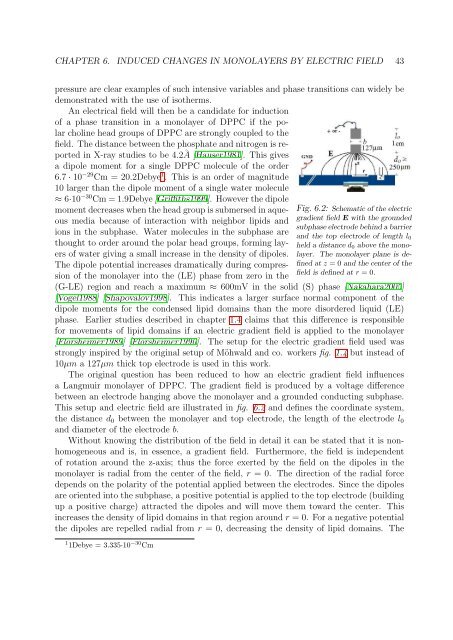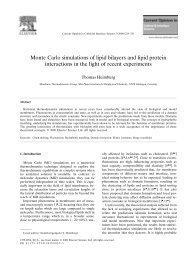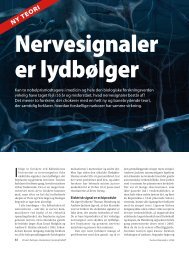Electric Gradient Field Applied to Lipid Monolayers - Membrane
Electric Gradient Field Applied to Lipid Monolayers - Membrane
Electric Gradient Field Applied to Lipid Monolayers - Membrane
Create successful ePaper yourself
Turn your PDF publications into a flip-book with our unique Google optimized e-Paper software.
CHAPTER 6. INDUCED CHANGES IN MONOLAYERS BY ELECTRIC FIELD 43<br />
pressure are clear examples of such intensive variables and phase transitions can widely be<br />
demonstrated with the use of isotherms.<br />
An electrical field will then be a candidate for induction<br />
of a phase transition in a monolayer of DPPC if the polar<br />
choline head groups of DPPC are strongly coupled <strong>to</strong> the<br />
field. The distance between the phosphate and nitrogen is reported<br />
in X-ray studies <strong>to</strong> be 4.2Å [Hauser1981]. This gives<br />
a dipole moment for a single DPPC molecule of the order<br />
6.7 · 10 −29 Cm = 20.2Debye 1 . This is an order of magnitude<br />
10 larger than the dipole moment of a single water molecule<br />
≈ 6·10 −30 Cm = 1.9Debye [Griffiths1999]. However the dipole<br />
moment decreases when the head group is submersed in aqueous<br />
media because of interaction with neighbor lipids and gradient field E with the grounded<br />
Fig. 6.2: Schematic of the electric<br />
subphase electrode behind a barrier<br />
ions in the subphase. Water molecules in the subphase are<br />
and the <strong>to</strong>p electrode of length l 0<br />
thought <strong>to</strong> order around the polar head groups, forming layers<br />
of water giving a small increase in the density of dipoles. layer. The monolayer plane is de-<br />
held a distance d 0 above the mono-<br />
The dipole potential increases dramatically during compression<br />
of the monolayer in<strong>to</strong> the (LE) phase from zero in the<br />
fined at z = 0 and the center of the<br />
field is defined at r = 0.<br />
(G-LE) region and reach a maximum ≈ 600mV in the solid (S) phase [Nakahara2005]<br />
[Vogel1988] [Shapovalov1998]. This indicates a larger surface normal component of the<br />
dipole moments for the condensed lipid domains than the more disordered liquid (LE)<br />
phase. Earlier studies described in chapter 1.4 claims that this difference is responsible<br />
for movements of lipid domains if an electric gradient field is applied <strong>to</strong> the monolayer<br />
[Florsheimer1989] [Florsheimer1990]. The setup for the electric gradient field used was<br />
strongly inspired by the original setup of Möhwald and co. workers fig. 1.4 but instead of<br />
10µm a 127µm thick <strong>to</strong>p electrode is used in this work.<br />
The original question has been reduced <strong>to</strong> how an electric gradient field influences<br />
a Langmuir monolayer of DPPC. The gradient field is produced by a voltage difference<br />
between an electrode hanging above the monolayer and a grounded conducting subphase.<br />
This setup and electric field are illustrated in fig. 6.2 and defines the coordinate system,<br />
the distance d 0 between the monolayer and <strong>to</strong>p electrode, the length of the electrode l 0<br />
and diameter of the electrode b.<br />
Without knowing the distribution of the field in detail it can be stated that it is nonhomogeneous<br />
and is, in essence, a gradient field. Furthermore, the field is independent<br />
of rotation around the z-axis; thus the force exerted by the field on the dipoles in the<br />
monolayer is radial from the center of the field, r = 0. The direction of the radial force<br />
depends on the polarity of the potential applied between the electrodes. Since the dipoles<br />
are oriented in<strong>to</strong> the subphase, a positive potential is applied <strong>to</strong> the <strong>to</strong>p electrode (building<br />
up a positive charge) attracted the dipoles and will move them <strong>to</strong>ward the center. This<br />
increases the density of lipid domains in that region around r = 0. For a negative potential<br />
the dipoles are repelled radial from r = 0, decreasing the density of lipid domains. The<br />
1 1Debye = 3.335·10 −30 Cm







